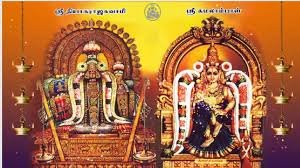Thyagaraja Temple Tiruvarur
Thyagaraja Temple is a Shiva temple, located in the town of Thiruvarur in Tamil Nadu state, India. Shiva is worshiped in the form of a lingam as Thyagarajaswami, also known as Putridankondar. His consort Parvati is worshipped as Goddess Neelotpalambika. She is also worshipped as Goddess Kamalambika, whose separate shrine is an important center for Shaktism and Tantra, and is also regarded to be one of the Shakti Peethas. The presiding deity is revered in the 7th century Shaiva canonical work, the Tevaram, written in Tamil by saint poets known as the Nayanars and the shrine is classified as a Paadal Petra Sthalam.
The temple complex covers 8.1 hectares (20 acres) and is one of the largest temples in India. It houses nine entrance towers known as gopurams. The tallest is the eastern tower, with four stories and a height of 30 metres (98 ft). The temple has numerous shrines, with those of Thyagarajaswami, Neelotpalambika, and Kamalambika being the most prominent.
The temple has six daily rituals at various times from 05:30 to 22:00, and twelve yearly festivals on its calendar. The temple has the largest processional chariot in Asia and the annual Chariot festival is celebrated during the month of March.
The present masonry structure was built during the Chola dynasty in the 9th century, while later expansions are attributed to Vijayanagara rulers of the Sangama Dynasty (1336–1485 CE), the Saluva Dynasty and the Tuluva Dynasty (1491–1570 CE). The temple is maintained and administered by the Hindu Religious and Charitable Endowments Department of the Government of Tamil Nadu.
Etymology
The historic name of Thiruvarur was Arur and it finds mention in the 7th-century Shaiva canonical work, Tevaram.The term Thiru, meaning holy, is added to all temple cities that are mostly revered by the verses of Tevaram, which is the case of Arur becoming Thiruvarur. Another name of Thiruvarur is Kamalalayaksetra, meaning the “holy place that is an abode of lotuses”, hence the goddess’ name Kamalambika and the Kamalalayam tank; During the British Raj, the town was termed Tiruvalur,Tiruvaloor,and Thiruvalur.As per the district and municipality websites, the district has the spelling “Tiruvarur”, while the town has it as “Thiruvarur”.As per Hindu legend, the temple is the place where Parvati as Kamalambika, wished to marry Shiva as Thyagarajaswami, but her wish remained unfulfilled.
History
According to legend, a Chola king named Muchukunda obtained a boon from Indra and wished to receive a lingam icon of Shiva, depicting the latter dancing on the chest of Vishnu. Indra tried to misguide the king and had six other images made, but the king chose the right image and consecrated it in Tiruvarur. The Muchukunda Sahasranamam specifically refers to the deity as Anapaayamahipaala, and as Rajaveshadari (one who played the role of a king).
The temple is believed to have been initiated with a large complex by the Pallavas during the 7th century.Contemporary history of the temple dates back to the time of the Medieval Cholas. An inscription dated in the 20th regnal year of Rajendra I (1012–1044) beginning with the introduction “Tirumanni valara” is found on the north and west walls of the Thyagaraja shrine. It gives a list of gifts including a number of jewels and lamps to the deity. It records that the temple was built in stone in the regnal years of the king by Anukkiyar Paravai Nangaiyar. Besides the same lady liberally endowed gold for plating and gilding parts of the vimana, the entrance, and the four sides of the shrine. Copper was also donated for plating the doors, and corbels of the pillars of the mandapa in front of the shrine. This inscription meticulously records the weight of the endowed gold and copper, besides listing the various ornaments gifted to the temple with a description each of them.
The temple complex seems to have acted as the cultural model for the Brihadeeswara Temple in Thanjavur, built by Raja Raja Chola, wherein he enshrined an icon which shared with the icon of the Chidambaram Temple. The last Chola monarch to play an important role in the affairs of the temple was Kulothunga Chola III in the early part of the 13th century A.D. It attracted devotees of all schools and the Golaki Monastery was established in the 13th and 14th centuries. The temple also attracted Jains, which were attacked by Hindus, as is evident from the text Periya Puranam.
















